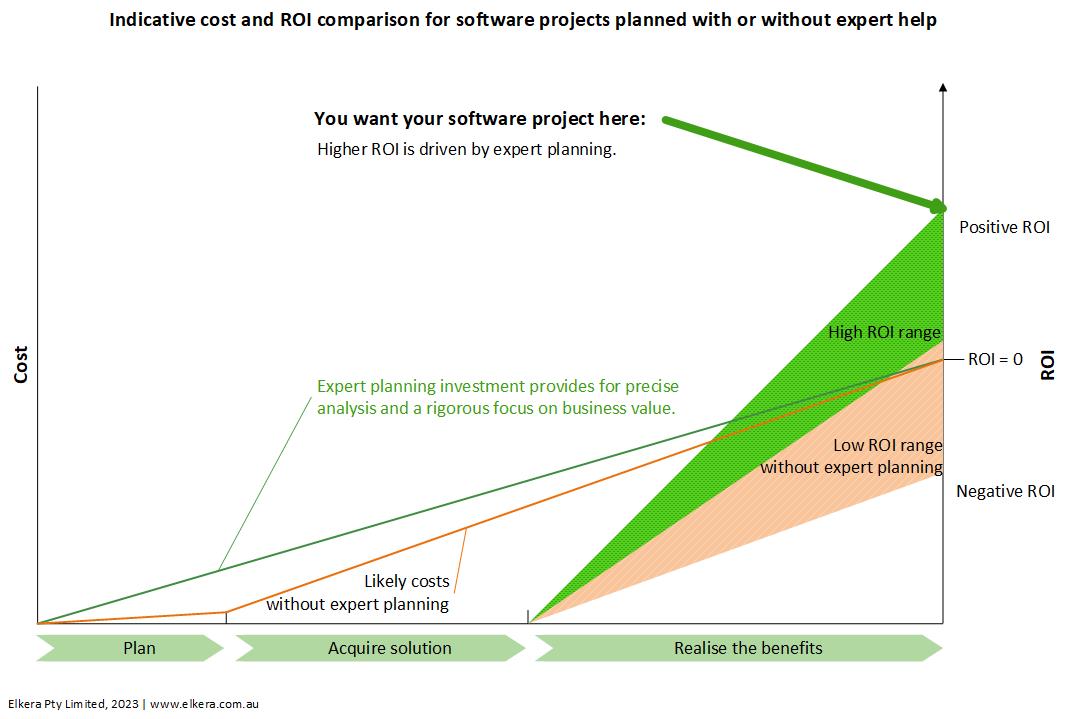Develop effective software requirements
Are you undertaking a business process improvement project or just planning to acquire new business software?
In business, software is a tool to automate certain business processes and to manage data. All new business software projects should be considered as business process improvement projects. You want to automate optimised processes, not old manual or inefficient processes. To reliably select the right software tools with the needed functions to meet your business needs it is essential to have effective software requirements.
Elkera helps small and medium enterprises (SMEs) to understand their business needs, improve their business processes and develop effective software requirements. With Elkera’s assistance, you will be able to procure new software tools that deliver real business value. You will minimise project risks, maximise return on investment (ROI) and satisfy your system users.
This page describes why it is necessary to take an expert driven, structured approach to developing software requirements and why Elkera is the expert to guide you through that process.
Effective software requirements require expert analysis and planning
Elements of a successful software project
A successful software project solves real business problems in a cost effective way. It has clear objectives, it takes account of all stakeholder needs, it is aligned to optimised business processes, it has clear, prioritised requirements and it is based on a thorough business case. Your system users should really want to use the installed system.
Reality check – The risks of software project failure
Unfortunately, many organisations fail to achieve success with their software projects.
According to reports by major research organisations, only around 30% of software projects are rated as successful. Most fall short of expectations. At least 20% of software projects are outright failures (See evidence gathered by the Standish Group and summarised in an article by Jorge Domingues at ProjectSmart UK: The Curious Case of the CHAOS Report 2009). Those are shocking statistics.
Many SMEs and other enterprises are wasting large amounts of scarce financial and human capital because of poorly planned software projects. That waste is completely unnecessary.
A common source of failure – inadequate software requirements
If you read most literature on software requirements, you are likely to be confused. There are many different ways to express software requirements and every business analyst seems to have their own take on it. They will speak of business requirements, functional requirements, traditional requirements (“Shall” feature statements), epics, user stories, and use cases.
The problem is that most writers think of software requirements from the perspective of the types of projects on which they work. Most writers are involved in developing software requirements for projects developed in-house, either within a large enterprise or within a software development business. Software requirements should be tailored to the needs of each project and the way that teams will work on that project.
The confusing messaging about software requirements creates uncertainty among business managers about what is required for effective software requirements on their projects, particularly for software procurement projects. Without a clear direction, it is easy to follow the wrong path.
Most SMEs do not have internal software development teams and do not employ business analysts. Many SMEs must acquire software from suppliers offering either off-the-shelf systems, developed but customisable systems, or fully custom solutions.
Unfortunately, in a misguided attempt to save money, SME managers may ask non-expert, in-house personnel to assemble requirements for proposed software systems. In those cases, there is a high risk that requirements will not do the job that is required. It is likely that the requirements will be highly ambiguous and incomplete. Most likely they will mimic existing manual systems and ignore important stakeholder needs. Without accurate, effective requirements based on optimised business processes, there cannot be a credible business case.
Alternatively, SME managers may proceed with only the simplest description of what they have in mind. They may make incorrect assumptions about the type of software they want.
Without adequate software requirements, potential solution suppliers may be invited to help the business devise a solution to its poorly defined problems.
That is a disastrous approach to software procurement. Without clear requirements, potential suppliers are unlikely to understand your specific business needs. Generally, potential suppliers are not being remunerated to do the work to really find out your requirements. Solution vendors may do their best but a good outcome may be a matter of luck.
Further, it is not possible to accurately assess competing solution offers because you are not comparing apples with apples.
If software procurement proceeds without effective requirements, there is a high risk that the system will fail to accurately meet your user’s needs. It is unlikely to satisfy any reasonable business case. The product may be used for some time, annoying many of its users. Alternatively, it is quite possible that procurement will be abandoned or a procured product will be abandoned shortly after deployment. As stated earlier, outright failure is alarmingly common.








